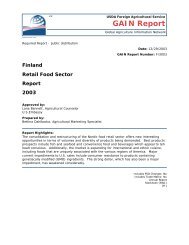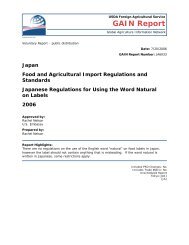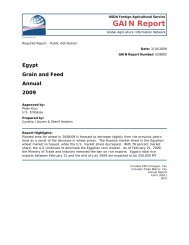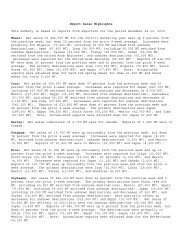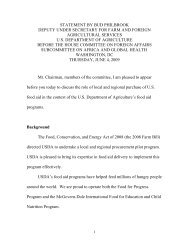Singapore Brief - Foreign Agricultural Service
Singapore Brief - Foreign Agricultural Service
Singapore Brief - Foreign Agricultural Service
You also want an ePaper? Increase the reach of your titles
YUMPU automatically turns print PDFs into web optimized ePapers that Google loves.
Country Profile<br />
Market Opportunities Report<br />
<strong>Foreign</strong> <strong>Agricultural</strong> <strong>Service</strong><br />
Horticultural and Tropical Products Division<br />
<strong>Singapore</strong><br />
Figure 2 <strong>Singapore</strong>’s<br />
financial district serves all of<br />
Southeast Asia’s economic<br />
needs.<br />
<strong>Singapore</strong>, with a population of over 3 million, is one of the<br />
most affluent nations in Asia with a GDP per-capita of about<br />
US$27,500. Twenty-three percent of the population are aged<br />
15 years and below, which represents a sizeable pool of future<br />
consumers who will be an important driver for increased<br />
consumption of imported food and beverages in future. More<br />
than 76 percent of its population make up the middle to upper<br />
income group of consumers, all of whom lead an urban lifestyle<br />
and represent the bulk of the market for imported food and<br />
beverages.<br />
<strong>Singapore</strong>'s economy is based mainly on its strong export<br />
manufacturing and financial and business service sectors. Until<br />
recently, its economy has been growing in excess of 8% per<br />
annum. In 1998, <strong>Singapore</strong> reported annual GDP growth of<br />
about 1.5%, after growth contracted in the second half of that<br />
year as a result of the impact of the recent Asian economic downturn. On a positive note, the<br />
economy to grew by 3 % in 1999, and the government forecasts economic growth for 2000 to<br />
be between 4.5% to 6.5%.<br />
Trade<br />
US exports of horticultural products in 1999 reached $94.8 million, up 4 percent from 1998,<br />
but still well below the $117.6 million registered in 1997. Much of the increase in 1999 was<br />
the result of increased exports of prunes and raisins, as well as almonds and pistachios. US<br />
fresh fruit exports declined slightly, especially oranges, which fell 55 percent from a record<br />
high of $11.2 million 1998 to $5.1 million in 1999. However, this was due primarily to supply<br />
problems from the US. Apple exports fell 11 percent from 1998 to 1999, hitting $3.9 million<br />
and grape exports fell 21 percent.
<strong>Singapore</strong> Market Opportunities Report Page 2<br />
Much of this decline is due to a general flatness in the fruit<br />
market as a whole. However, US exports recovered<br />
slightly in the first six months of 2000, up 8 percent over<br />
the same period in 1999. Key product recoveries include<br />
oranges, grapes, potato products, and wine.<br />
<strong>Singapore</strong>’s importance as a regional distribution hub<br />
<strong>Singapore</strong> is generally recognised as Southeast Asia's main<br />
distribution hub. The facilities offered by its airport and<br />
seaport have encouraged a large number of businesses,<br />
including food manufacturers and ingredient suppliers, to<br />
base their operations in <strong>Singapore</strong>.<br />
Figure 3 <strong>Singapore</strong> boasts the<br />
busiest port in the world in terms<br />
of shipping tonnage<br />
In 1998, US$ 1.41 billion of food and beverages were reexported<br />
from <strong>Singapore</strong> to various countries in the world. Of this, around 30% were shipped<br />
to ASEAN countries, with Malaysia being the main destination. A large proportion of<br />
imported fresh fruit is re-exported to as many as 14 different countries worldwide. Re-export<br />
to neighbouring ASEAN form significant proportions, as much as 100 % for some product<br />
segments, of the re-export trade out of <strong>Singapore</strong>. <strong>Singapore</strong>’s market for fresh fruits is<br />
supplied solely by imports. It imports fresh fruits for its own consumption and for re-export to<br />
other countries in Asia and the Pacific islands.<br />
Market size<br />
In 1999, the total fresh fruit import market in <strong>Singapore</strong> is valued at around US$ 270 million<br />
in imports of fresh fruits, made up of fresh tropical fruits and fresh temperate fruits. Fresh<br />
temperate fruit imports form around 60% of total import value. The re-export market of fresh<br />
fruits amounts to around US$100 million, of which 40 % was for fresh temperate fruits.<br />
<strong>Foreign</strong> <strong>Agricultural</strong> <strong>Service</strong><br />
Horticultural and Tropical Products Division
<strong>Singapore</strong> Market Opportunities Report Page 3<br />
Imports -<br />
The top 3 major supply countries in 1999 are shown by the table below:<br />
Major Supply Countries and Their Import Market Shares (1999)<br />
Oranges, excl. Mandarins USA (38%), Australia (32%), South Africa (14%)<br />
Grapefruits (excludes pomelo) Israel (39%), USA (33%), South Africa (12%)<br />
Apples China (28%), New Zealand (25%), USA (16%)<br />
Grapes USA (46%), Australia (40%), Chile (5%)<br />
Pears (Non-Asian variety) Australia (57%), South Africa (12%), USA (7%)<br />
Stone fruits Australia (43%), USA (42%), China (8%)<br />
Berries USA (57%), Australia (19%), New Zealand (17%)<br />
Source: <strong>Singapore</strong> Department of Statistics<br />
As can be seen by the table above, the US is a major supplier of many fresh temperate fruits to<br />
<strong>Singapore</strong>. However, the strong dollar and keener competition form third country suppliers<br />
are putting pressure on US exports. The US share of the apple market slipped from 19% in<br />
1998 to 16% in 1999 as a result of increased Chinese shipments. Similarly, the US share of<br />
the orange market fell significantly from 50% of non-Mandarin oranges to 38% due to short<br />
supply from the US and the strength of the US dollar versus the Australian dollar. Australia<br />
held a 32% share of the market in 1999, up from 27% in 1998.<br />
Re-exports<br />
<strong>Singapore</strong> re-exports fresh temperate fruits to 14 different countries, however about 90% of<br />
all fresh fruit go to other ASEAN countries. The major fresh temperate fruits which are reexported<br />
include apples, pears, oranges, mandarins and tangerines. The main re-export<br />
destinations for these fruits are Malaysia, Brunei and Thailand.<br />
<strong>Foreign</strong> <strong>Agricultural</strong> <strong>Service</strong><br />
Horticultural and Tropical Products Division
<strong>Singapore</strong> Market Opportunities Report Page 4<br />
The recent regional economic downturn has had a significant impact on the re-export trade for<br />
fruits and vegetables and is expected to continue its downward trend. The main re-export<br />
country affected was Malaysia which successfully launched a “Buy Malaysia” campaign in<br />
1998 to minimise the impact of the economic recession on its consumers, thus reducing the<br />
country’s imports. Furthermore, well targeted infrastructure improvements in Malaysia, such<br />
as the recently completed Port of Tanjung Pelepas (PTP) provides a modern deep water<br />
facility in Johore Baru, the Southern most state on the Malay peninsula. Maersk Sealand, the<br />
largest shipping company in <strong>Singapore</strong>, will be moving to PTP in December 2000, bringing<br />
with it an estimated 2 million twenty foot equivalents in 2001. Also, the newly developed<br />
high tech Westport at Port Klang, the primary entry point for Kuala Lumpur, has further<br />
enhanced Malaysia as a shipping destination. These improvements in Malaysia, which is<br />
<strong>Singapore</strong>’s primary re-export point may reduce <strong>Singapore</strong>’s role as trans-shipment point.<br />
Trade sources comment that no real opportunities exist for re-export of fresh temperate fruits<br />
from <strong>Singapore</strong> to other ASEAN countries, such as Indonesia, due to the added freight<br />
charges. However, given the uncertainty of some ASEAN economies, traders are increasingly<br />
using <strong>Singapore</strong> as banking center while arranging for direct shipment to the intended<br />
destination.<br />
Growth Prospects - Domestic Market<br />
Trade sources comment that the fresh temperate fruits market has been doing very well in the<br />
past five years and is likely to grow by between 5% and 10% over the next three years.<br />
However, in the near term, they expect the market for fruits and vegetables to be flat due to<br />
the slowdown in consumer consumption. When the Asian crisis began to affect the <strong>Singapore</strong><br />
economy, the government reduced the mandatory company contribution to employee<br />
retirement funds from 20 to 10 percent. However, many <strong>Singapore</strong>ans use their retirement<br />
funds to finance home loans. When the company contribution was lessened, individuals had to<br />
dip into their take home pay to service the loans, causing consumption rates to slow.<br />
They also comment that, to be successful in the market for the long term, the most important<br />
factors are price and quality. The US supplier has to compete with suppliers from countries<br />
such as Australia and New Zealand which also supply very high quality fresh temperate fruits.<br />
These countries are nearer to <strong>Singapore</strong> and so are able to offer the benefits of shorter<br />
shipping time and lower freight charges.<br />
<strong>Foreign</strong> <strong>Agricultural</strong> <strong>Service</strong><br />
Horticultural and Tropical Products Division
<strong>Singapore</strong> Market Opportunities Report Page 5<br />
Fresh temperate fruits have been gaining popularity among <strong>Singapore</strong>ans. Per capita<br />
consumption per annum of fresh temperate fruits has grown from 52 kilograms in 1994 to 58<br />
kilograms in 1998. Consumption reached as high as 65 kilograms per capita in 1996 when<br />
<strong>Singapore</strong> was still at the height of its economic growth. Opportunities exist for the following<br />
fruits:<br />
Oranges, mandarins and tangerines especially for the festive seasons such as Chinese New<br />
Year celebrations when very large quantities are demanded. In some years, there were actual<br />
shortages of mandarins and tangerines for short periods of the high demand seasons. Major<br />
retailers are always scouting for new sources each year, well in advance of Chinese New Year,<br />
to avoid potential short supply situations. Other citrus such as lemon and limes are generally<br />
not consumed in the same manner as the other fruits but are used to make fruit juices or used<br />
in local food recipes. They are mostly sold to the food service sector although they are<br />
available by retail.<br />
Apples. Varieties such as Fuji and Royal Gala continue to be popular and opportunities exist<br />
to supply the demand for such apples. However, US suppliers have to meet consumer demand<br />
for quality, taste and price. Red apples such as Royal Gala, Fuji and Red Delicious are<br />
popular varieties because of their taste, texture, juiciness, colour and size although the Red<br />
Delicious variety is not favoured as much as the other two varieties. The Royal Gala and the<br />
Fuji are considered of better quality as they taste sweeter, handle better and show less damage<br />
on the fruits. The Pink Lady, Golden Delicious, Granny Smith and Braeburn varieties are not<br />
very popular except with expatriate shoppers.<br />
Pears. The Packham variety remains the most popular European pear variety. However, it can<br />
only meet demand for part of the year due to its growing season. Chinese pears are still the<br />
preferred pears in <strong>Singapore</strong> as these are traditional fruits which have a different taste, texture<br />
and colour to the European variety. They are preferred because of the crunchy and juicy<br />
characteristics of these pears, and command as much as 75% o f the pear market.<br />
High quality fresh stone fruits, grapefruits and berries targeted at the high end restaurants and<br />
hotels. Such establishments are always on the lookout for new and exotic fresh fruits to offer<br />
their patrons and niche demands exist in this sector of the market. Niche demand opportunities<br />
also exist in supermarkets.<br />
<strong>Foreign</strong> <strong>Agricultural</strong> <strong>Service</strong><br />
Horticultural and Tropical Products Division
<strong>Singapore</strong> Market Opportunities Report Page 6<br />
Fresh tropical fruits form as much as 55 % of the total quantities of fresh fruits consumed by<br />
<strong>Singapore</strong>ans. Such fruits form part of local food culture and are well understood by all local<br />
consumers. In addition, they are readily available and are lower priced compared to fresh<br />
temperate fruits.<br />
Distribution patterns<br />
The bulk of fresh fruits are imported by local importers. Most fresh temperate fruits are airflown<br />
to <strong>Singapore</strong> to maintain the freshness demanded by the consumers. The fresh fruits are<br />
then distributed via wholesalers and distributors to retail outlets throughout <strong>Singapore</strong>. Most<br />
retail outlets and food service outlets source their fresh fruit needs from wholesalers although<br />
the larger retailers have started to source for fresh fruits directly from the overseas growers to<br />
cut out the middlemen’s costs and pass on the cost savings to their customers.<br />
NTUC Fairprice, the island’s leading retailer with about 55% of total supermarket sales is<br />
constructing a new cold storage facility that will service all its stores and enable the retailer to<br />
import directly.<br />
While the Asian crisis was painful, it served to reduce the number importers in the market,<br />
eliminating some of the weaker players. Some companies have managed to hang on but most<br />
trade sources implied that many will succumb to market forces.<br />
Most fresh fruits are still sold through wet markets which are found within every housing<br />
development. However, as more <strong>Singapore</strong>an women enter the work place, many traders<br />
believe that supermarkets will gain in importance with regard to the fruit trade.<br />
Challenges:<br />
- Handling: The hot climate which can rapidly reduce the product quality. Fresh temperate<br />
fruits have to be stored and distributed under cool conditions to prevent any deterioration in<br />
the quality. While <strong>Singapore</strong> has one of the most modern port facilities in the world, and a the<br />
supermarkets are of a high standard, much of the wholesale distribution systems are not fully<br />
refrigerated. Many transport trucks are not equipped with cooling either.<br />
<strong>Foreign</strong> <strong>Agricultural</strong> <strong>Service</strong><br />
Horticultural and Tropical Products Division
<strong>Singapore</strong> Market Opportunities Report Page 7<br />
The poor handling by retail staff which can result in damage to the product quality. Fresh<br />
fruits of all varieties are still handled poorly in most supermarkets. It is not unusual to find that<br />
fresh temperate fruits being poured out of the original packaging box by retail store staff<br />
without due care and attention to whether the fruits will become bruised or damaged from the<br />
rough handling.<br />
Poor understanding of temperate fruits by both the retailers and the consumers. Temperate<br />
fruits that are not in optimum condition for consumption can often be displayed for sale, to the<br />
detriment of future sales of such fruits. The consequence is that consumers often complain<br />
about the poor taste of such fruits and ignore them in future. For example, market<br />
opportunities for a newly introduced variety of apples can be minimised if this occurs,<br />
particularly if the displayed apples are not at their optimum ripeness/sweetness stage.<br />
- Third Country Competition:<br />
Although the above countries grow temperate fruits in different seasons, new technology has<br />
allowed fresh fruits from both the North and South Hemisphere to interact on a competitive<br />
basis at certain times of the year. Hence, USA, China, Australia, New Zealand and France<br />
frequently have fresh temperate fruits in the market at the same time, e.g. from October to<br />
December of each year, apples from all these countries appear in the supermarkets.<br />
<strong>Singapore</strong>ans do not understand the difference between the old season and new season fruits<br />
so there is no preference shown by consumers for older or newer season fruits. This is<br />
exacerbated by the strong dollar in relation to all competitor currencies.<br />
China is becoming a major player, shipping Fuji apples and various pear varieties. Quality is<br />
expected to be good, and improving, especially as China develops its controlled atmosphere<br />
capabilities.<br />
Many non-profit trade associations use FAS’ Market Access Program (MAP) to generically<br />
promote US horticultural products in <strong>Singapore</strong>. Furthermore, FAS works with State<br />
Regional Groups to allocate branded MAP funds for <strong>Singapore</strong> and other countries. To learn<br />
more about MAP, please visit: http://www.fas.usda.gov/mos/programs/mapprog.html . If you<br />
are a producer or exporter and want to participate, contact a trade association that represents<br />
your specific product. If no trade association exists, contact one of the four State regional<br />
trade groups:<br />
<strong>Foreign</strong> <strong>Agricultural</strong> <strong>Service</strong><br />
Horticultural and Tropical Products Division
<strong>Singapore</strong> Market Opportunities Report Page 8<br />
- Eastern US Ag & Food Export Cncl (EUSAFEC), website: http://www.foodexportusa.org<br />
- Mid-America International Agri-Trade Council (MIATCO), website: http://www.miatco.org<br />
- Southern US Trade Association (SUSTA), website: http://www.susta.org<br />
- Western US <strong>Agricultural</strong> Trade Association (WUSATA), website: http://www.wusata.org.<br />
For more information on the <strong>Singapore</strong> market for horticultural products, contact:<br />
Bonnie Borris (resident in Kuala Lumpur), Director<br />
Bernard Kong, <strong>Agricultural</strong> Specialist<br />
Alice Kwek, <strong>Agricultural</strong> Marketing Specialist<br />
U.S. <strong>Agricultural</strong> Trade Office<br />
541 Orchard Road, 15-03 <br />
Liat Towers, <strong>Singapore</strong> 238881<br />
Tel: (011-65) 737-1233/737-1729 <br />
FAX: (011-65) 732-8307 <br />
Internet Email: ato_sing@pacific.net.sg <br />
Web page: http://www.atosingapore.org.sg/<br />
<strong>Foreign</strong> <strong>Agricultural</strong> <strong>Service</strong><br />
Horticultural and Tropical Products Division



